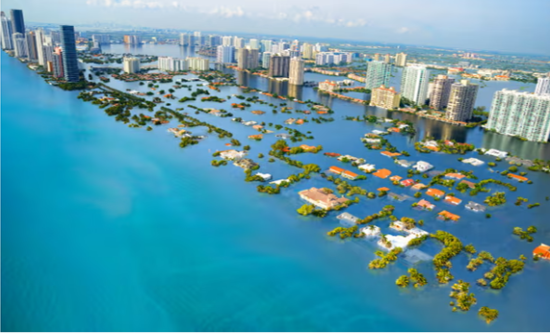A briefing offered by The Economist news magazine recently stated “Global warming is coming for your home.” The briefing forecast a US $25 trillion bill that American homeowners will face in the not-too-distant future from the physical risks of climate change.
What are these risks? They include storms, floods, fires, heatwaves, rising sea levels and other extreme climate events accompanying rising atmospheric temperatures.
That $25 trillion bill doesn’t include the cost of retrofits and renovation to legacy homes to make them climate resilient and livable under changing conditions.
An American dream is to own a home overlooking a beautiful beach and water. If you watch HGTV’s “House Hunters” you certainly can see the attraction to pay a premium price for living by the ocean or a lake. Climate scientists, however, forecast that homes on the seashore will be vulnerable to rising sea levels, extreme weather events, flooding, and storm surges.
If you know Florida, it is extremely flat. Much of South Florida is only a few metres above sea level even when you go well inland. This area of the state will see a sea level rise of 0.9 metres (3 feet) by 2060 based on current trends. That number will likely double by 2100.
The Florida government estimates that 934,000 homes in South Florida will be at risk of being lost. The state has developed planning tools and studies but none of the actions taken by it or local municipalities is sufficient to stop an ocean inundation. No South Florida home by a beach or on nearby low-lying land will survive.
The aforementioned $25 trillion bill for Americans compounds many more trillions when we look at homes across the rest of the planet.
For example, China faces its multi-trillion-dollar challenge in the Pearl River Delta, near Hong Kong. This is Guangdong Province, home to 127 million Chinese. It is the economic engine of China and vulnerable to the same extreme conditions South Florida will experience. The Pearl River Delta includes the megacities of Guangzhou and Shenzhen. In the past month, both experienced severe flooding from one extreme precipitation event losing thousands of homes.
Projected sea level rise for the Pearl River Delta is expected to be 1 metre (3.3 feet) by 2100. The Chinese have been far more aggressive than South Florida’s government in hardening the infrastructure of the province to sea level rise and extreme weather risks. The investment may still not be enough to save millions of homes.
Globally, the economic toll of extreme weather and climate-change-related events continues to grow. China’s 2023 losses from torrential rains, landslides, hailstorms and typhoons in just nine months amounted to $42 billion. Africa from 1970 to 2021 has seen losses amounting to $43 billion. The European Union has reported its losses for the same period at $562 billion. South America’s hit $115.2 billion. By far the largest amount in losses, however, were recorded in North and Central America including the Caribbean nations reaching $2 trillion.
Somewhere in these multi-billion and trillion-dollar numbers, homeowners figure in. The World Bank, in its annual economic calculations for losses noted recently that it does not directly quantify homeowner and property value loss in its climate data. One study, however, covering a ten-year period ending in 2019 that looked at climate-related economic costs totalling $1.5 trillion, attempted to measure homeowner losses based on insurance claims and lost property value estimates.
At some point, homes that face heightened climate risk will become liabilities for private insurers to underwrite. Extreme weather claims will no longer be insurable in South Florida. Similar predictions in other jurisdictions include a Bank of England estimate that by 2050, 7% of UK homes will be uninsurable, and in Australia, the independent environmental advisory body, the Climate Council has forecasted one in 25 homes will turn the country into “an uninsurable nation.”
For private insurers still writing policies for homeowners in places like South Florida, future claims for climate events will likely be treated as “secondary perils” making them equivalent to “acts of God.” Claims will be denied. And as private insurers give up issuing policies, homeowners will turn to the state as the insurer of last resort. That’s already happening in Florida. Even then, however, the government as insurer doesn’t guarantee a homeowner will be paid should an extreme weather event occur. A growing inventory of uninsurable properties is the outcome which points to an unsustainable future where even the government will have no collateral upon which to base its payouts, particularly if the property is underwater.
















